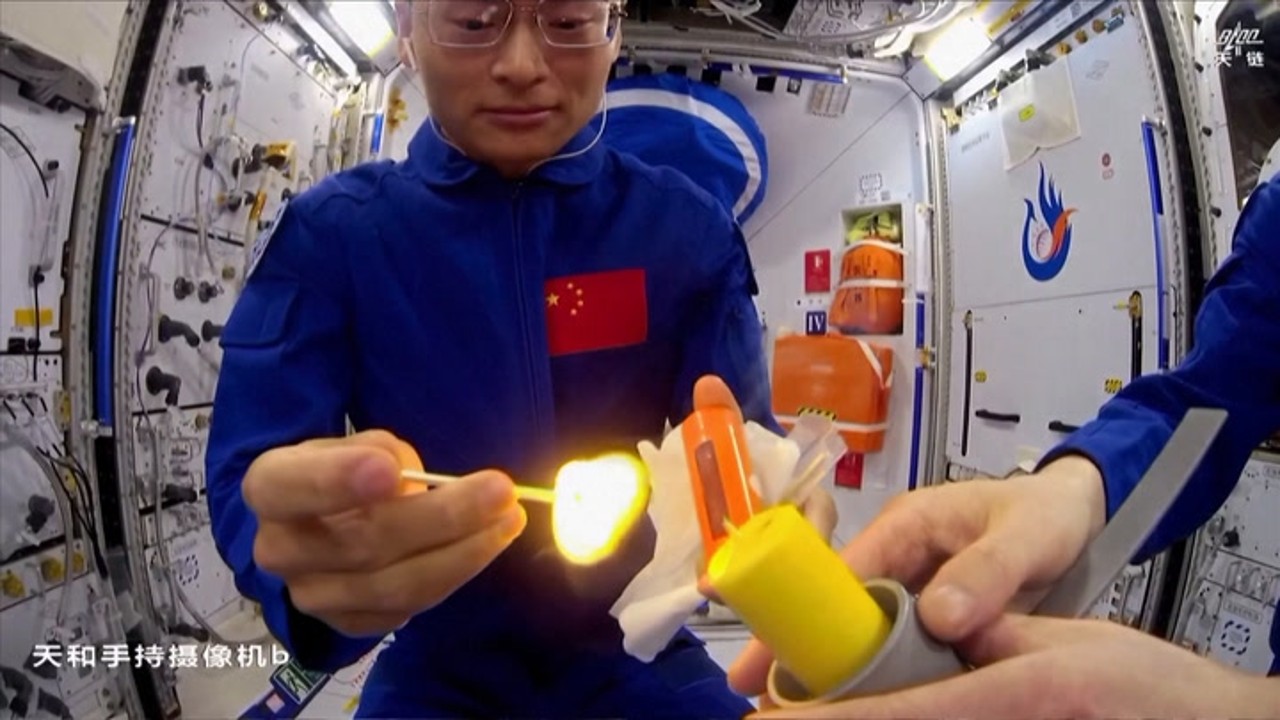Watch Chinese astronauts light a match on Tiangong space station (video)
The candle experiment would likely be impossible on the International Space Station, which has strict rules regarding flammable materials and open flames.
China's Shenzhou 16 astronauts conducted an eye-raising experiment in space involving open flames aboard the Tiangong space station.
Astronauts Gui Haichao and Zhu Yangzhu lit a candle during a live lecture broadcast from China's Tiangong space station on Sept. 21 to demonstrate how flames burn in microgravity. Strikingly, the flames appear nearly spherical, rather than the teardrop-shaped flames we're familiar with back on Earth.
Lit candles on Earth produce flames shaped through buoyancy-driven convection, with hot air rising and cold air descending. That combustion convection current is weak in the microgravity environment of low Earth orbit, however. This means flames diffuse in all directions, resulting in spherical fireballs.
Related: Fire-in-space experiment could soon make its way to the moon

The livestreamed lecture was the fourth so-called "Tiangong classroom" hosted on China's space station. The astronauts interacted with students in five classrooms across China, demonstrating a number of microgravity phenomena. As with previous classrooms, the astronauts demonstrated that many physical processes behave differently than they do on Earth.
However the candle experiment — in which Gui strikes a match to produce an open flame to light the candle — would likely be met by surprise by International Space Station participants, who have strict rules regarding flammable materials and open flames.
I made this - that time ESA astronaut @Astro_Alex made Mission Control think he might have snuck an actual candle onto @Space_Station. It's amazing what you can do with an old penlight and some spare metallic tape: https://t.co/5UvfA1kC8j pic.twitter.com/TFlHX42YOpMarch 9, 2021
Strict fire safety measures aboard the ISS are in part a response to a significant fire on the Russian space station Mir in in 1997.
Get the Space.com Newsletter
Breaking space news, the latest updates on rocket launches, skywatching events and more!
Combustion in microgravity has been the subject of numerous experiments on the ISS, but usually using a specially-designed combustion integrated rack, keeping fire isolated and contained.
Tiangong also has its Combustion Experiment Rack (CER) for serious research in this area.
Join our Space Forums to keep talking space on the latest missions, night sky and more! And if you have a news tip, correction or comment, let us know at: community@space.com.

Andrew is a freelance space journalist with a focus on reporting on China's rapidly growing space sector. He began writing for Space.com in 2019 and writes for SpaceNews, IEEE Spectrum, National Geographic, Sky & Telescope, New Scientist and others. Andrew first caught the space bug when, as a youngster, he saw Voyager images of other worlds in our solar system for the first time. Away from space, Andrew enjoys trail running in the forests of Finland. You can follow him on Twitter @AJ_FI.
-
Unclear Engineer The match and the candle are two different types of flames. The match is not dependent on atmospheric oxygen to initially light and burn - it is more like a solid rocket motor. But, once the fuel + oxidizer mix is consumed, the match stick burns like a candle wick. In that case, it burns less energetically in microgravity because it cannot set up buoyancy driven convection due to gravitational effects on density differences in that air around it. So, it tends to suffocate itself with its own combustion products. At least the candle does generate some flow by heating the wax and causing it to vaporize, which tends to push the wax vapor away from the candle and toward the flaming wick, and some ambient air with oxygen is drawn in to the flow. Similar to what happens in gravitational fields, but not as robust flow rates. So, the flame around the candle wick is not 'spherical" so much as half-spherical.Reply -
med WOW. Absolutely fantastic Guys. I love that you are motivating and inspiring kids back home. Please keep up the good work and stay safe.Reply









